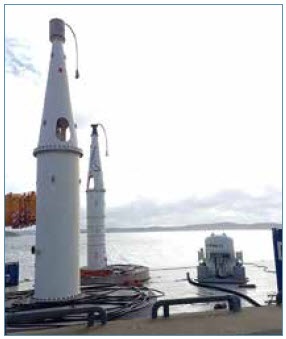SWEDEN
RESEARCH & DEVELOPMENT
KEY R&D INSTITUTIONS AND RELEVANT R&D PROJECTS
Uppsala University
The Division of Electricity at Uppsala University conducts research on wave energy technology and hydrokinetic energy conversion from tidal, ocean currents and rivers. At the moment, the wave power research group at the Division of Electricity consists of 16 PhD students and 13 senior researchers. Wave energy activities are focused on a full system approach, including system modelling and control, generator and buoy design and model development.
Marine current research projects include resource potential studies as well as system modelling from water currents, via turbine and generator, to grid. In order to verify research results, Uppsala University operates two research sites: Lysekil wave power research site and Söderfors marine current research site. The Swedish Energy Agency is supporting theoretical and experimental works related to the Lysekil project as well as theoretical work behind the Söderfors project.
|
The Lysekil project: The Division of Electricity continued the activities on real sea testing at the Lysekil research site in 2014. Preparations have been made for a 140 kVA grid connection via a 1 kV/11 kV substation near the measuring station on Härmanö. This is planned to be finished in January 2015. One wave energy converter and one low-voltage marine substation have been assembled and are waiting to be deployed at the test site when the weather allows. At the same time, three to five installed wave energy converters are planned to be connected to the substation and fitted with buoys and put into operation. The produced electricity will be consumed by loads in the measuring station on Hermanö until grid connection (including permits) is established. In November, the permission for the Lysekil test site was prolonged for 20 years. The new permission includes a large increase of the area of the test site, now covering 0.5 km2. The new permission allows up to 20 wave energy converters, two substations and two sea cables. One of the reasons for this expansion is to further enable external actors to utilize the test site for research and testing of wave energy, and related marine technology. There is interest from both national and international organizations and companies. The Söderfors project: The Söderfors marine currents research site is located in Dalälven River. The site has been chosen as it seemed suitable for experiments at low water velocities. Research is carried out with regards to both the resource and the technology. The resource is studied through resource assessments and velocity measurements with Acoustic Doppler Current Profilers (ADCPs). The technology that is being tested at the site consists of a fixed pitch vertical axis turbine connected to a directly driven permanent generator. During 2014 most of the work focused on the control system and the future grid connection of the energy converter.
The department is also involved in the VINNOVA funded project Offshore Väst. The project was initiated primarily together with the research institute SP. Offshore Väst brings together industry, research organisations and public. authorities in the offshore field. One of the work packages in the project (WP2: Marine renewable energy) engages several researchers and lecturers in the department; hence work is being done both through education and research. Chalmers is responsible for work package WP4 – Offshore Academy.
Some of the projects that SP is involved in are: |
|
- Offshore Väst, which aims to establish and support the offshore sector in Sweden through a setup of projects and strategies. Offshore Väst is owned by a consortium of dedicated companies, universities, institutes and authorities.
SP is the project manager and coordinator for the work package concerning offshore energy production from wind, wave and current.
- Pilot study – Test site for marine applications. This project was carried out during 2013 and investigated the possibilities of establishing a national sea test bed. It included topics like market research, geographical position, metrology study, consent process and grid connection. SP was the project manager and coordinator.
- Buoy to grid aims at supporting the ocean energy industry with applied research focusing on electrical systems, reliability and marine safety. SP was the project manager and coordinator.
- Strategic Innovation Agenda for Marine Electricity Production. This was conducted during 2014 and SP put together an agenda for ocean energy together with Uppsala University and Fortum.
- During 2014, SP was also involved in a project assigned by the Swedish Energy Agency, which included a mapping of Swedish ocean energy sector and their visions and needs.
SSPA Sweden
SSPA Sweden has performed development in ship design and operations within the maritime sector, in close cooperation with industry and society, over the past 75 years. SSPA is working in several areas related to ocean energy such as risk analyses before establishment, bio-fouling and countermeasures, reliable measurement methodology, wave measurement, system and hydrodynamic calculations and simulations. SSPA has three major test facilities that are well suited for marine energy testing. To carry out full scale tests at sea is often a very extensive work and involves significant costs. Before testing, the prototype stage may be performed in model scale under controlled conditions. At SSPA facilities, the generated waves and flowing water are utilized to test wave power plants, other marine energy technologies and the development of turbines.
With the help of simulation studies, SSPA has investigated the function and performance conditions for the WaveTube wave power plant. Another project involved the company Minesto, in which their underwater kite Deep Green was tested in several steps in the SSPA Towing Tank. The technique was refined and adjusted before real tests in ocean water using prototypes.
Other relevant universities are Blekinge Institute of Technology that has supported the company Ocean Harvesting Technologies AB with development of simulation models and facilities for the test rig as well as KTH Royal Institute of Technology that has supported the company CorPower Ocean AB.





